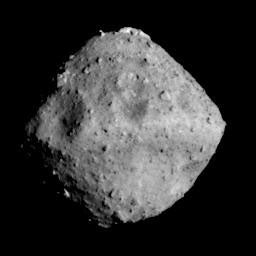Mission hints space rocks could have made life possible on Earth
Asteroids like Ryugu could have gifted Earth its water and the building blocks for life

Space rocks could have made life on Earth possible, according to a breakthrough new study that looked at a near-Earth asteroid.
Asteroids and comets are time capsules, nuggets of materials saved in the deep freeze of distant space since the earliest days of our Solar System, and so to planetary scientists, represent a precious and unique window to a past that eventually led to all life on Earth.
Scientists can learn a lot from these time capsules using telescopes and other instruments to study them from afar, but the real treasure can only be dug up through literal digging — sending a sample return mission to an asteroid, digging into it, and returning to Earth with the goods. And that’s just what the Japanese Space Agency’s Hayabusa 2 mission accomplished by returning 5.4 grams of the near Earth asteroid Ryugu to Earth in December.
In a paper published Thursday in the Proceedings of the Japan Academy, an international team led by researchers at Hokkaido University and the Tokyo Institute of Technology detail their findings from analysis of the insides of the samples returned from asteroid Ryugu. They not only found evidence that Ryugu likely formed as part of a much larger icy body at the edge of the infant Solar System, but that it contains water and amino acids, suggesting similar asteroids could have supplied the young Earth the materials necessary for life.
The Hayabusa 2 mission launched in 2014 and reached Ryugu in 2018, where it then sampled both surface and subsurface materials. Hayabusa 2 then swung by Earth and dropped the sampled materials to scientists waiting below. Early impressions confirmed what scientists largely already knew, that Ryugu was a C-type, or carbonaceous asteroid, very dark in color and thus difficult to study from afar.
In the time sense the samples were first returned, researchers have cut into them using a diamond blade, and inside researchers found a collection of minerals embedded in clay, suggesting the asteroid had undergone a period of freezing and thawing that peaked just 2.6 million years after the formation of the Solar System.
The researchers now believe 1 kilometer-diameter Ryugu was once part of a much larger planetesimal tens of kilometers in size. Large enough that radioactive elements would have melted ice within the planetesimal, creating the matrix of minerals and clay observed in the samples, before the water refroze as most of the radioactive elements decayed over 5 million years.
It’s theorized that comets result from collisions between icy planetesimals at the outer reached of the Solar System, and that Ryugu experiences a similar origin, eventually making its way to the inner solar system, much of its surface ice sublimating — shifting from a solid phase to a gaseous phase in one step — which could have set the asteroid spinning and given it the “spinning top” shape observed today.
Scientists believe asteroids made of material similar to Ryugu would have been common around the early Earth, which has profound implications for life as we know it.
The new research has confirmed the existence of amino acids on Ryugu, the organic building blocks of life forming entirely in space, a process scientists theorized took place, but could never confirm on the basis of meteorite samples since such space rocks had already passed through Earth’s atmosphere and could be contaminated.
Ryugu and especially Ryugu like space rocks in the early Solar System would also have contained plenty of water.
Getting those two ingredients, amino acids and water, to the surface of the Earth was an essential step in life’s history, humanity’s history, and the Ryugu samples suggest theories that asteroids and comets provide both materials to the primitive Earth are on the right track.
Hayabusa 2 is not the the first time Jaxa has returned samples from an asteroid. The Hayabusa 1 mission returned samples from asteroid Itokawa in 2005, but those samples amounted to just a few micrograms of dust.
Hayabusa 2 is also not the last sample return mission.
Nasa’s Osiris-Rex mission will return samples from asteroid Bennu, a B-type asteroid with a composition very different to Ryugu’s, providing researchers with a valuable contrast. Nasa also plans to return samples taken from the surface of Mars by the Perseverance rover to Earth sometime in the early 2030s.
Taken together, such sample return missions represent a new phase in planetary science and astrobiology research, one where scientists are finally able to not only look, but to touch.
Join our commenting forum
Join thought-provoking conversations, follow other Independent readers and see their replies
Comments
Bookmark popover
Removed from bookmarks